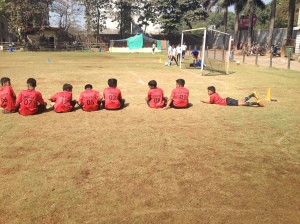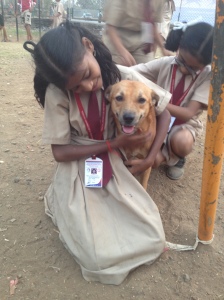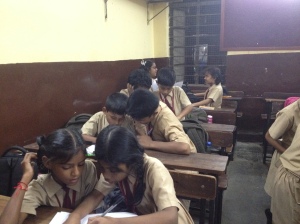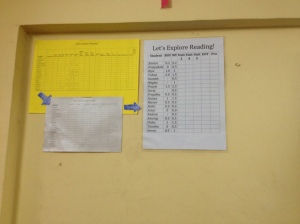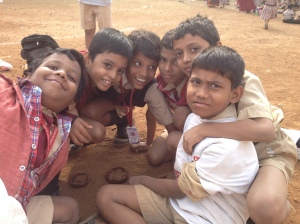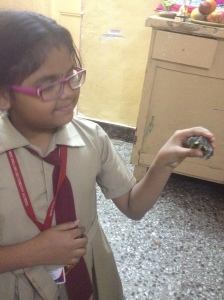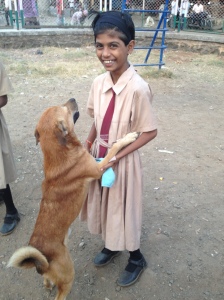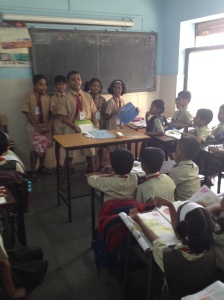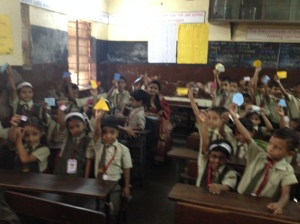
Prologue:
It’s not that I gave up writing. I just moved to a more personal platform, because that’s what happened in my second year: everything became so much more intimate. Each lesson and each action had so much more of me – so much of the kids – and of what we had created, together. It felt intensely private, in the alluring way secrets tend to be. So I wrote for myself: quotes, memories, pictures – trying to capture the magic of the everyday.
But then, as I sat at our Alumni Induction (what TFI has cleverly decided to call the graduation ceremony from the Fellowship), I couldn’t help but feel a disconnect.
I liked what people said, more or less. I was inspired by the children’s performances. I even maybe sort of half-laughed and half-cried in disbelief when my own students spoke about me through the video. I made Divya and Aditya jump as I grabbed their arms and subsequently smirk with amusement as I sat baffled. These two kids left me awestruck at the depth and clarity of their thoughts and ideas. Even after two years, they surprised me – and alongside pride, I felt this burning desire once again that I could have done more, been more.
Yet, I didn’t find that moment that symbolized the clichéd “end of an era” for me – the moment when I felt ready to move on.
That’s why I’m here. I think, in some ways, we need to search for our own closure. Our journeys were so different, our challenges varied, our approaches and paths divergent. How can any individual expect to speak at a ceremony, under the stark light of the stage, and present a summative view of tumultuous 2-year journey in the span of a few minutes? We are as disparate as each of our kids, and these two differences (the fellows and the students) were the only constants that moulded the fellowship into the experience it was.
First Year:
At the end of my first year, I felt strong. Confident I had created an impact. Yes, I understood how much work there was to be done, and I had a whole year left to do it. It was easy to categorise my experiences, using a few words like “unexpected” and “impact” to tie together the disjointed memories, the hours of learning, planning, playing, teaching, and reflecting. It was easy to speak about having let the experience change me as well. And the thing was, it was all true. I had become better, stronger, more confident. My students had benefited. The journey had been eventful, unexpected, exhausting, and rewarding. And I had very few filters when people asked me about the same.
The Things that Mattered:
However, now at the end of my second year, I’m struggling to find words to adequately express this journey. I’m unsure which details I want to share, and which I want to cocoon like soft secrets between my students and me.
Of course, right off the bat, we should all acknowledge that the fellowship was not any one thing (and to try and categorise it as such would be nothing short of folly.) Please don’t tell me it was about “love” because it wasn’t – not always. Maybe love was the undercurrent, the wave, and the sky above our heads. Maybe it even was the tremor in my aching voice and the twinkle in my students’ eyes as they teased me. But there was no love in the unforgiving heat, nor the scrutinising gaze of distrustful parents. There were days I couldn’t find it in the corridors, I couldn’t see it in the numbers keeping score on our walls. There were days when the wet pillow couldn’t tell me where love was, and my minuscule lettering in my lesson notebook held no secrets within its folds.
Yet, even on those days, when a tightened chest held a hopeless heart, fingers gripped chalk, voices rumbled, and students learned. In some ways, the fragile wavering beauty of those days – like the overcast sky lending a small respite – beat the glaring sunshine. When we moved past our egos and kept going – even when if didn’t feel the bright rays of love – those were the most miraculous days. Those were the days where the sun floated inside the walls to shine from the corners of our classrooms.
In fact, the days that mattered the most were not the glaring ones, demanding attention with bright lights in your eyes. They were the small actions – a child apologizing without prompting, a parent sending you lunch, the shy girl in the back raising her hand for the first time.
The beauty of it is that it was the furthest thing from perfect. It was raw, unplanned, and broken. There are fragments of this glass that will haunt me – the mistakes I made, the cost of not being able to rectify them. But these same fragments, sometimes turned in a particular way, perhaps even by mistake, can transform a small beam into a bedazzling array of lights and reflect this glory across the four walls – and maybe beyond.
The beauty of the fellowship is that I cannot truly tell you about it. Every time I write, I keep thinking, “I forgot to include this. How can I not talk about this?” I have reacquainted myself with the delete button again. Moreover, I especially cannot tell you about your part of it, so unlike mine, so uniquely challenging and special in its differences. But perhaps, I can make you feel mine for a few brief moments.
Reliving Moments (song):
Hot tears slapping on your cheeks, each drop a new failure – rebuffing you even though you can’t even pinpoint what the hell happened, what you did wrong. Clenching your heart tight, full of fear, apprehension, self-doubt. And then small, tiny hands reaching inside fearlessly – unknowingly – and unclenching it. Replacing that fear with something you’ve known – joy – but this kind of joy seems new. It seems boundless, infinite, innocent, unreserved, undeserved. It’s honest – it yells and screams and defies – and still smiles when you furrow your brows and explain and punish and defy. It greets you with a “Hi, Didi” as if you didn’t just scold it, it shows its missing front teeth with all the inhibition of a street dog, and it pulls you into its world of open doors and much-too-sweet chai and riding around on shared cycles, teasing friends with words borrowed from Tarak Mehta.
And now you’re scared again. But this is a new fear, a fear of losing this, of not delivering enough, being enough – of letting them down, because they’ve pulled in their parents, their aunts, their brothers and sisters, and all these eyes are resting upon you. And you’re just a child, hardly able to manage your own self, sort through the thoughts fighting for dominance in your head, but you have to do this – there are no excuses. Instead, it’s like you teach them – one foot in front of another, one failure follows another, and we learn – we learn together. You teach them about your world – nouns, verbs, fractions, logic, contradiction, probing, thinking, analysing, creating – and they teach you about theirs – forgiveness, innocence, honesty, trust. You talk to them about grit, excellence, taking ownership, respect, and they show you friendship, loyalty, leadership, and love.
It’s not like you’re ever alone. You’re never without them. In bookstores, you always wander to the children’s section, even if you’ve come shopping for yourself. Your anecdotes are peppered with revelations about those small humans, about the small world you’ve built with them inside your classrooms. You watch with envy as others sleep away lazy Sundays while you run around on a football field or spend hours correcting the same mistakes in fifty different papers. Still, for reasons you can’t articulate, you wouldn’t trade this experience. Not for anything.
When there’s yelling, screaming, and anger, you can’t look around for an adult to fix your students’ issues (you’re the adult). There’s no choice but to step forward, to teach them what’s right, and explain until your lips are sore why why why we must do this. You’ll become a master at making kids process their actions, analyze their behaviour, correct their mistakes. And sometime during all this, you’ll wake up and realise you’ve become the adult you’ve been pretending to be. As Divya said, “It’s funny, they force us to grow up while helping to keep alive the child within us.”
Our Paradoxes
Nothing great is without its paradoxes, and the fellowship is no exception. It’s the frustration at the organization, juxtaposed against the thud in your heart at being a part of something so great, so wonderful. It’s the marvel at the opportunity. It’s the amazement at the people you’re surrounded by. It’s the affection for the community that becomes a second family. It’s the lack of support and structure and accountability. It’s the camaraderie with the staff, guiding you no matter which year they were or which school they taught in. It’s the people with whom you share your joys and your fears. It’s the strength you discover within these people, the strength to keep going when the children don’t seem like enough – when even your own heart doesn’t seem like enough. It’s the bonds you know you’ll carry, the changes in yourself you’ll treasure, the memories that will pave the path to your future.
Hope
A few months ago, I heard Snyder’s Hope Theory. What struck me was the subtle difference between optimism and hope.
optimism – the belief that the situation will improve
hope – the belief that the situation will improve, and I have a part to play in it.
The Fellowship helped me believe in my agency. It transformed optimism into hope.
At the end of these two years, there’s an overwhelming understanding of the challenges – and an understanding that perhaps we’ve only grazed the surface of the potential pitfalls in these two years. There’s an understanding that in the vast world, our students and us are just a drop in the ocean (albeit perhaps a lovely, multi-faceted, bright little drop.) There’s an understanding that there’s so much to be done, and so much yet to learn. That perhaps the longer you spend, the more you don’t know.
But there’s also a belief that simmers beneath this understanding: a belief in our “One Day.” We will make it happen. Our kids will make it happen. The path is kind of grey and invisible, and sometimes even menacing. And yet, some of the fear dissipates when you realise you’re not stepping onto it for the first time; you’re already in the middle. There are people behind you, next to you, and ahead, and as we tread down the path, hearts beating wildly, we are shaping the path, changing the path, and making it our own.
This last part is for our students, who keep asking why we’re leaving them. And my only answer is this:
Because you’ve shown me how wonderful, brilliant, compassionate, self-aware, and thoughtful you can become, given the right opportunities. And I have to leave, to play my small part in making sure these opportunities find the millions of other children like you who deserve them. It’s you who will always inspire me and push me as I journey onwards. I’m leaving you for the only thing that could possibly make me leave you: the millions of other children like you who deserve the same. And I know we’re going to make it happen, together.


